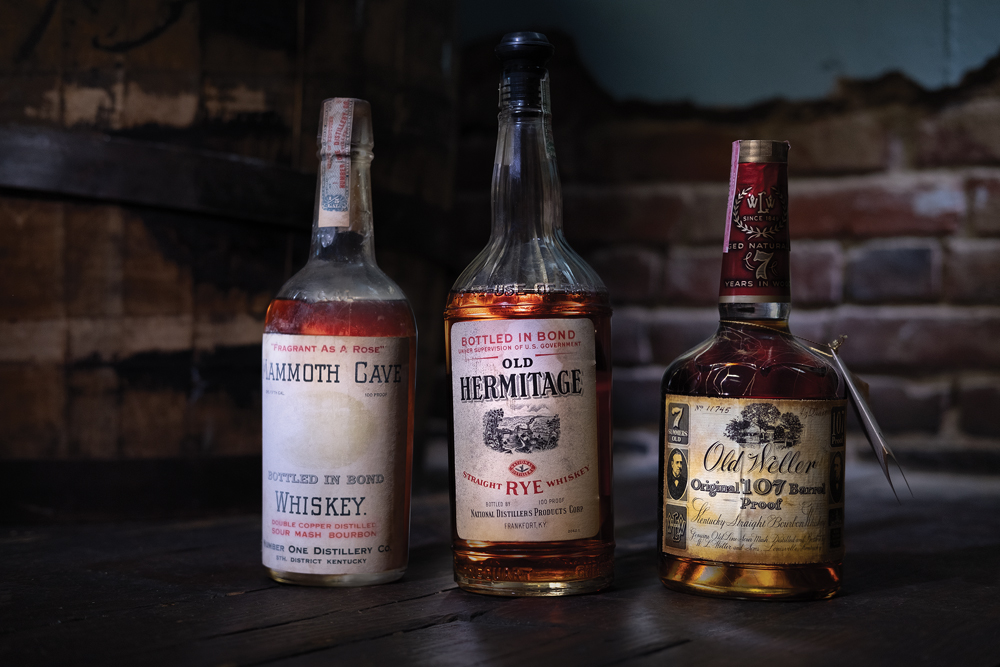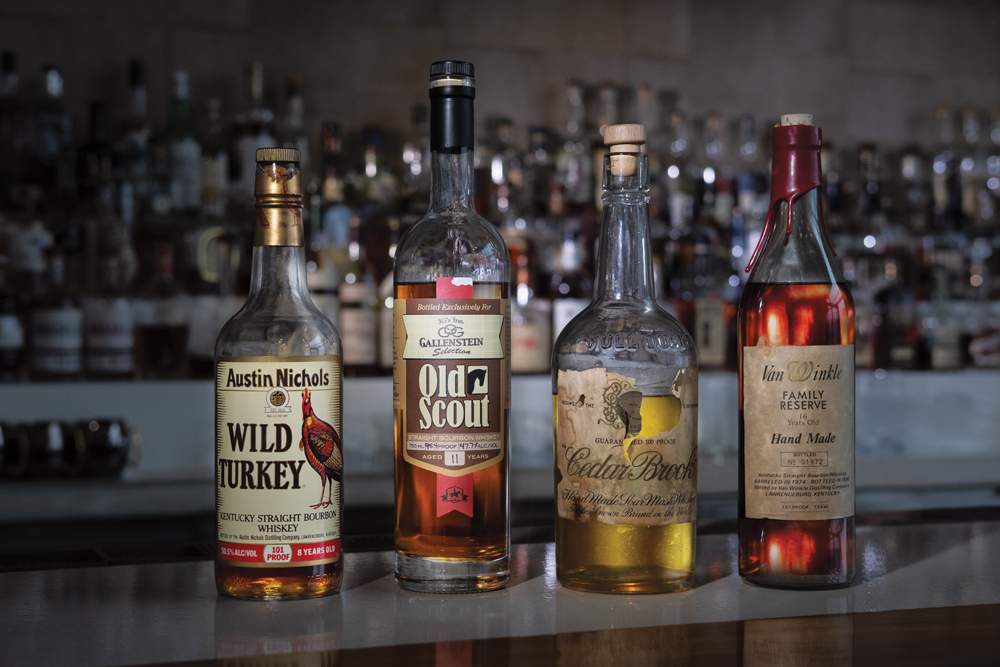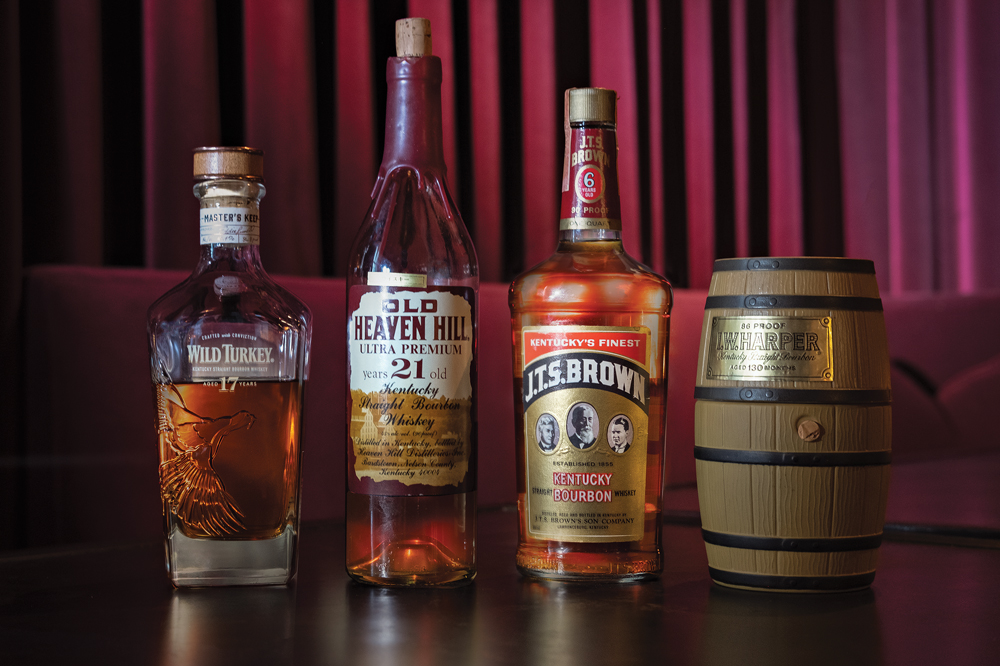When Larry Rice was a kid growing up in Texas, his mom and grandma would always drag him to flea markets on weekends. He’d sit in the car and complain while they’d be inside antiquing for old Pennsylvania Dutch finds. “And then you get bored and you start going in and then all of a sudden you get a weird little collection and the good deal kind of bites you,” says Rice, who in 2011 opened the Silver Dollar, a honky-tonk-themed bourbon bar and restaurant in Clifton. At first, he got into pocketknives. These days, Rice does one or two road trips a year with his mom, antiquing across the country and collecting carnival knickknacks that his “better half,” Silver Dollar beverage director Susie Hoyt, says are creepy. “Antiquing was an easy transition into vintage whiskeys,” Rice says, “’cause it’s the same thrill you get finding that good deal or finding that rare thing.”
About six or seven years ago, he turned what should have been a seven-hour drive into a five-day road trip to Kansas City, Missouri, avoiding highways and stopping in mom-and-pop liquor stores along the way. At one stop, he started talking with the owner and ended up in the back surrounded by Stitzel-Weller brands from before the Shively distillery originally closed in 1972, and Old Crow Chessmen decanters from the 1960s. Rice left with 11 cases — more than 100 bottles — for $700 or $800. “Nowadays, each of those is that much,” he says.
That’s because the days of what’s called “dusty hunting” — seeking out older and under-the-radar bourbons collecting dust on shelves — are largely over, replaced by an age of high-ticket vintage and rare whiskeys sold through auction houses and among those in the know. Collecting “in the wild,” as it’s referred to by enthusiasts and in chat groups, now requires incredible time investment with few returns. “If people want to get into it now,” Rice says, “they need to be well-funded. I couldn’t afford to have the collection I have if I started today.”
Early last year, Kentucky passed a law allowing licensed bars and retailers to sell spirits purchased from a private citizen, meaning anything no longer in distribution could now make it to your glass. That’s why you may have noticed — at the Silver Dollar, for instance — the list of six whiskeys that sell from about $15 a pour (Barton’s Hiram Walker Ten High from 1990) on up to in the $300s (Old Crow’s Old Hermitage Rye from 1941). Those come from the hundred or so vintage bottles in a glass case at the restaurant, which come from Rice’s personal collection of several thousand bottles. He’s got a bottle of Mammoth Cave, a Stitzel-Weller brand from the ’40s that would go for about $4,000 today. He’s got a gallon-sized bottle of Old Grand-Dad from the ’60s, which sits in a wooden swing. He estimates it would sell in the $4,000 range. (He won’t say how much he paid for those two.) “I remember when I thought it was a lot of money to spend $8 on a pour of bourbon,” he says. “I was like, ‘Eight bucks? Must be really good.’”
Now, with the new law, Rice frequently gets calls from people wanting him to buy a stash they found in their grandparents’ basement or in a lucky estate-sale haul. “They’re not calling me with $30 bottles that sit on the shelf for $30,” he says. “They’re calling me with $30 from the shelf that are now $1,500 and $1,800.”
Louisville-based bourbon writer Fred Minnick is like a rare bottle of bourbon himself: high value and in-demand. Minnick, known for books like Bourbon Curious, Bourbon: The Rise, Fall & Rebirth of an American Whiskey and Whiskey Women: The Untold Story of How Women Saved Bourbon, Scotch and Irish Whiskey, does reviews for Forbes, runs a magazine called Bourbon+, has an Amazon Prime show called Bourbon Up and creates the bourbon and culinary programming for the Bourbon & Beyond music festival. And now the Smithsonian wants him as a guest lecturer.

A few of Silver Dollar owner Larry Rice's antique whiskeys. He estimates some of them are worth $4,000 today.
In early January, when I meet with him at the Bardstown distillery Bardstown Bourbon Co., he casually mentions his recent appearance on Bravo’s Kentucky-themed season of Top Chef. After filming, he says, he and judge-producer Tom Colicchio cracked open some bottles from Minnick’s personal collection from the ’30s and ’50s. Minnick says he “made the mistake” of telling the BBC in 2015 that the Old Crow Chessman decanter from 1969 (the same dusty that Rice found) is the best bourbon he’s ever tasted, and he credits his opinion with bringing it to near extinction in the wild. But there are bottles of it in a padlocked cage at Bardstown Bourbon Co., where Minnick has curated what’s called the Whiskey Library at the Bottle & Bond Kitchen and Bar. It includes more than 400 vintage and rare whiskeys that cost up to $2,500 for a pour (like for Van Winkle Hand Made, barreled in 1975 and bottled in 1990).
Minnick shows me a bottle (likely the only one in the world) of Cedar Brook Hand Made Sour Mash whiskey from the 1890s, before bourbon was legally defined as such (when, in 1964, the U.S. Congress defined bourbon as distinctly American, with all sorts of standards in production). The Cedar Brook is yellow and has what’s called “flocking,” a swirl of fatty acids suspended in the liquid that occurred before chill filtration was so commonly used like it is today. It smells like leather. It costs $1,600 a pour. Minnick points to a bottle of Van Winkle Family Reserve Hand Made, barreled in 1974 and bottled in 1990, that sells for $1,500 a pour. It’s got red dripping wax — a Maker’s Mark infringement that drew cease-and-desist letters, meaning only a couple hundred were bottled. “That’s a trophy for some people,” Minnick says.
With the connections Minnick has built, it’s not hard for him to find this type of rarity. On the day we meet, he has already gotten about five emails from people wanting to know how much their bourbon is worth. Last fall, the Speed Art Museum reached out to him about partnering with Bourbon & Beyond on a rare-bourbon benefit auction. “I said, ‘No problem. I can get whatever you want. I can get things so rare, you won’t even believe it,’” Minnick says. “They looked at me like — uh-huh, OK.” One find was the 10th bottle ever made of 23-year-old Pappy Van Winkle Family Reserve, which the seller had gotten as a gift from Julian Van Winkle III (grandson of Julian “Pappy” Van Winkle Sr. and president of Old Rip Van Winkle, which has its office in Louisville but distills and bottles its Pappy products at Buffalo Trace in Frankfort). The asking price: $20,000. The other heavyweight in the auction was a 1952 Albert Blanton 55th Anniversary bottle that Blanton, then the master distiller of the George T. Stagg distillery (now Buffalo Trace), had picked out for an employee, who then passed it down to a granddaughter. That one was valued at $10,000 and sold for $10,500. The Pappy? No one bit. “Most of the buyers at high levels don’t value Pappy as much as the rest of the population,” Minnick says. “They know the whiskey; they know what else they can get that’s similar to it. I have no doubt it probably would have sold for $15,000.”
While wine and mead have been collected for centuries, Minnick says bourbon didn’t start seeing this type of hype until about 10 years ago. “American whiskey was kind of always thought to be the poor man’s drink, whereas scotch was for the Wall Street guy,” he says. It’s not just age and rarity that draws collectors. Bourbon is history. It’s time travel. Minnick pours a taste of Wild Turkey, barreled in 1977 and bottled in 1985, and says, “This is to an era of leaded gasoline and people still using typewriters.”
In December, a stash of vintage spirits sold for $3 million at Christie’s Auction House in New York. Among the stockpiled supply were 40 cases of unopened pre-Prohibition whiskey. It all came from the family of a California millionaire who had built secret vaults in his mansion, anticipating Prohibition. And just a few months ago, Marianne Eaves, master distiller at Castle & Key in Versailles, made headlines for re-creating a 100-year-old bourbon she found at the distillery, once the home of Old Taylor. She figured out the chemical compounds and determined the recipe.
Chet Zoeller used to find bottles on eBay for $150 to $250. The historian, author and co-founder of the Louisville brand Jefferson’s Bourbon started collecting bourbon about 20 years ago, when he and his son Trey (now head of Jefferson’s) were just starting out. Many are pint-sized medicinal bottles. Those same bottles — pints — can go for $1,000 to $1,500 today. “About four or five years ago, somebody whispered in eBay’s ear that you couldn’t sell those on the site, so that dried up and went away,” Zoeller says. Since September, the Frazier History Museum downtown has had many of his 160 bottles on display as part of a “Spirit of Kentucky” exhibition.

Some of the more than 400 vintage spirits available at Bardstown Bourbon Co.
In early January, Butchertown Grocery chef-owner Bobby Benjamin closed his restaurant for renovations that included adding shelving for his antique bourbon collection. His love of bourbon has been a progression, from when he grew up in Rhode Island and Tennessee watching his dad drink Wild Turkey 101 to now, running a restaurant that often does events with the brand. Bourbon is not just a beverage for Benjamin. He’s constantly coming up with new ways to use its byproducts, like mash and barrel staves. He works closely with Matt Jamie at neighboring Bourbon Barrel Foods and has a shelf of 16 jars of quinoa, peanuts, cherries and other ingredients — all bourbon-infused, in one way or another. He currently has olive oil and balsamic vinegar in used bourbon barrels. “It’s almost like bourbon is the new umami,” Benjamin says. “You can manipulate food with bourbon. A smoked grit is nothing like you’ve ever had in your lifetime. It’s kind of like, ‘Oh, wait a minute, what just happened?’” He plans to showcase some of his vintage bourbons in these ingredients. “We’ll have a lock on here, obviously,” he says. “I would love to compare the uniqueness of antique bourbon next to the uniqueness of bourbon-infused ingredients.” He and beverage director Nic Christiansen have recently picked 14 private barrels — meaning the bottles come from a single barrel of a type of bourbon, say, Maker’s Mark, rather than being blended with other barrels, allowing for a unique taste and color profile — and they plan to do 20 more this year. “When we were thinking about this year, we were like, OK, what barrels are we pickin’, and then what antiques are we buying?” Benjamin says.
Many of these coveted vintage brands, and the majority of those in Zoeller’s collection, ceased production long ago. “Bourbon was huge before Prohibition,” Zoeller says. “It literally paid for the operation of the federal government. The average consumption was two to three gallons a year, including children and teetotalers.” A lot of his bottles have prescriptions on the back, as bourbon was touted as having medicinal properties up through Prohibition. “Whiskey that they made back then is considerably different than whiskey that they’re making today. It’s almost become more standardized,” Zoeller says. “I’m delighted to say, I’ve opened a few (really old) bottles and tried them, and the whiskey is just wonderful.” He says that, if a bourbon is bottled well, it should taste like it would have the day it went into the bottle. “Once you take it out of the barrel, everything stops,” he says.
On a recent Friday night at Bourbons Bistro on Frankfort Avenue, bartender Mike Downs — “Like Churchill,” he says — spots me eyeing the list of bourbons in the $1,000-to-$5,000-a-bottle range. “Oh, you want to see the owner’s closet list?” he says, handing me a wrinkled paper that lists owner Jason Brauner’s bottles for sale. They range in price from $1,500 (for a 1978 Jim Beam Red Corvette, a decanter that actually looks like the car) up to $15,000 (for a bottle of I.W. Harper Prohibition whiskey, aged from 1916 to 1934). Downs starts pulling out different decanters — a 1978 Jim Beam telephone decanter, a 1972 Cabin Still Ducks Unlimited bottle, one of the Old Crow Chessman bottles. “Someone once bought one of these and returned it, said it was musty. And?” Downs says.
Butchertown Grocery’s Christiansen says that taste is part of what makes older bottles so fascinating. She recalls a time when Wild Turkey master distiller Eddie Russell was at the restaurant and introduced her to some guys from Boston who had a bottle of 1990 Wild Turkey 12-year (aka “Cheesy Gold Foil” because of its gaudy label). She recalls Russell saying that he always asks his dad, longtime master distiller Jimmy, “How did you make that stuff? I’ve tasted from barrels, different parts of the warehouse, different floors, trying to find it.” And his dad says, “I didn’t do anything different. I just made bourbon.”

Bottles from Butchertown Grocery owner Bobby Benjamin's growing collection.
“The mouthfeel of antique bourbon is just different,” Christiansen says. “It’s dusty, almost. I’m sure when there wasn’t the bourbon boom, the barrels weren’t as new, the wood wasn’t as new. You have to think about the trees when they’re grown and how old they are before they get cut down. They also weren’t selling as much bourbon, so if it says (aged) 10 years, it might be 14 years.”
Minnick says that sometimes old bourbon can go bad though, like if a bottle has been sitting in a garage next to a can of gasoline or a litter box and the fumes seep in through the cork. Rice has tasted pours of vintage whiskey at bars in other cities that have developed a flat taste after being open for too long — three to nine months seems to be the limit. “You lose the mid-palate,” he says. A bar in Chicago gave him the idea to preserve his opened bottles with a vacuum pump typically used on wine bottles. He tried it on a bottle of 1941 Old Hermitage and says that it was still good a year later. “You gotta remember, these things haven’t seen oxygen in 30, 40, 100 years, so when they get air it reacts,” Rice says. And while whiskey’s flavor profile, in theory, doesn’t change once it’s in the bottle, that all depends on how well it’s sealed, the mechanisms of which have changed from decade to decade. “They used cheap corks for a period of time and it smells like Grandma’s mothballs,” Rice says. For these reasons, he tastes everything before he puts it on the menu.
Minnick owns some bottles he probably won’t ever open. “I think to myself, you know, this is a little bit like my son’s college savings,” he says. And while it’s hard to predict the bourbon stock market, tomorrow’s golden liquid might be on shelves today. Minnick mentions Heaven Hill’s Henry McKenna, a single-barrel bourbon aged for 10 years. Last spring at the San Francisco World Spirits Competition, Minnick was a judge when it won best bourbon. And it sells for $30 to $40 a bottle. “Anything from Heaven Hill has potential to be the whiskey anytime in the foreseeable future,” he says.
Rice mentions Silver Dollar’s house-selected single barrels of Old Forester, which are aged about four years and cost $8 or so per pour. “They don’t fly off the shelves because it’s a younger whiskey, but it’s still super-unique and it’s delicious and affordable,” he says. “There’s a lot of great whiskey out there. But it’s maybe not as exciting because it’s easy to get.”
This originally appeared in the February 2019 issue of Louisville Magazine under the headline "Bottle Rocket." To subscribe to Louisville Magazine, click here. To find us on newsstands, click here.
Photos by Joon Kim, studiojoon.com



